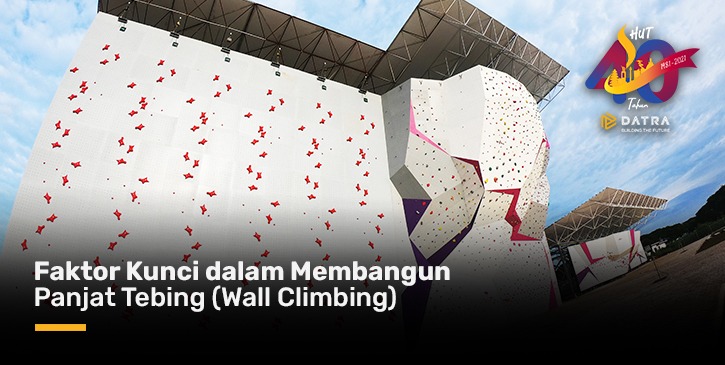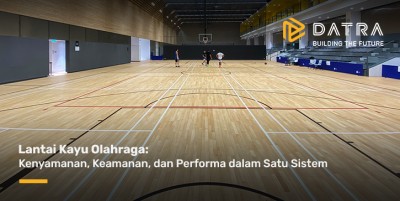Key Factors in Building Wall Climbing
Education, Construction
February 18, 2022

Wall climbing or rock climbing is an extreme sport that requires certain techniques to get through it. Not only in carrying out the movements, building this sports facility also requires techniques that are recommended to be carried out by experts.
Rock climbing has 3 types of walls to be used as competitions based on the International Federation of Sport Climbing, namely Speed, Leads and Boulder. These three walls have their own challenges and specifications.
Detail | Speed | Leads | Boulder |
Height | 16.7 meter | 13 - 16 meter | 4.5 meter |
Wide | 6 meter | 12 meter | 35 meter |
Tilt Profile | 50 | 100-600 | 50-600 |
Overhang | 1,3 meter | 7-11 meter | n/a |
Roof Cover | v | v | v |
Mattress | - | - | v |
Altitude System | v | v | - |
Timing System | v | - | - |
In building this sports wall, there are several key factors that must be considered, such as structure, panels, holds (points), mattresses, timing system, and height aids.
Structure
In the construction of a rock climbing wall, the structure is the most basic thing and must be considered when planning. The wall structure consists of a frame that is connected in such a way as to form the desired type of wall. The slope and contour of the wall are determined by the shape of this structure. In general, the rock climbing structure is divided into 3 parts, namely Self standing structure, Primary Structure and Secondary Structure).
As the name suggests, the self-standing structure is the main structure that becomes the "foundation" on the wall. This structure is in the form of thick steel that is assembled so that it has the desired strength and is planted in the ground, or walls that have been judged to be strong.
Second, the Primary Structure which is a structure attached to the self-standing structure and forms the first slope and contour for the rock climbing wall panels. This structure is made of thick steel, but not thicker than the self-standing structure. The last is the Secondary Structure which is in charge of creating contours or curves on the rock climbing path. Because of this task, the structure uses adjustable steel..
Panel
Panels on rock climbing are boards that are used to place holds or points so that they can resemble natural cliffs. These panels can be made of multiplex or fiber composites with an average thickness of 20 mm. On the panel, you can see the holes with 125 mm spacing between the holes, which is the standard of the IFSC (International Federation of Sport Climbing). This hole later useful for installing hold (points). The shape of the panels is adjusted to the rock climbing discipline, can be straight, and can also be shaped to have contours or curves.
Holds (Points)
Holds or often called points are handles on rock climbing that are attached to the panel. The form of the holds varies according to the discipline of rock climbing, whether it is used professionally for competition, training, or recreation. Holds have 3 types of materials, namely:
Polyurethane (PU): a material that is lightweight, yet durable and has color. This material is suitable for curved surfaces.
Polyester (PE): made of resin that has a dry to the touch and abrasion resistant finish, and is recommended for flat surfaces. This material must use an Explosion Proof System (EPS) which prevents the hold pieces from falling if the bolt retainers are cracked.
Wood: used specifically for certain exercises and volumes
For the safety and convenience of users, Holds must also follow a series of test reports EN 12572-3 and EN 1176-1 specifically for playground needs for children over 2 years old. In addition, the number of holds also affects the safety of climbing. For boulder walls, it is recommended to use 5 to 15 holds per meter from bottom to top (4.5 meters). For wall leads, it is recommended to use around 40 holds consisting of 25 hand holds and 15 foot holds in each lane. In order not to look full, we recommend that you have a maximum of 2 to 3 routes on a single wall.
Mattress
Mats in this sport are used specifically for boulder walls. This is because the discipline of boulder focuses on climbing techniques and has a height of only 4.5 meters, so it does not use height aids, but uses a mat as a safety. Mats in this sport must have a thickness of 400 mm, and be installed at +2.5 meters forward, right and left side of the outer end of the wall.
Timing System
This timing system is only used for competitions, which are generally used on speed walls. The timing system for rock climbing consists of a timer system, start pad, finish pad, indicator light, time display, and speaker.
Altitude Aid
On the rock climbing wall leads and speed, the height aid that must be installed is the auto belay. This tool is installed hanging at the top end of the wall to keep athletes safe when descending from the top wall. By utilizing internal friction, the belay belt can lock at a certain descent speed. In addition, athletes are also required to use personal height aids such as carabiners, quickdraw, karmantel (rope) and body harness.
Once you know these key factors, you can easily figure out what you need next in rock climbing. If you need further assistance with the design and installation, we are here to help.


